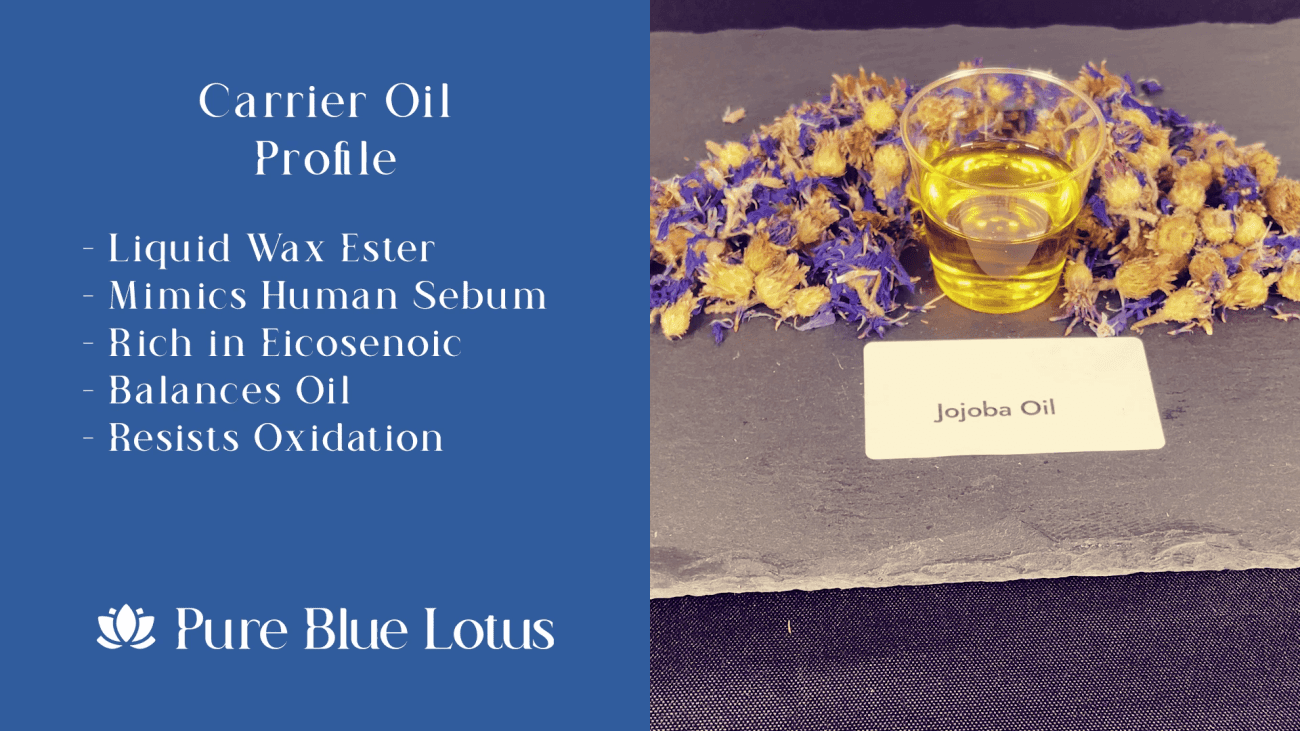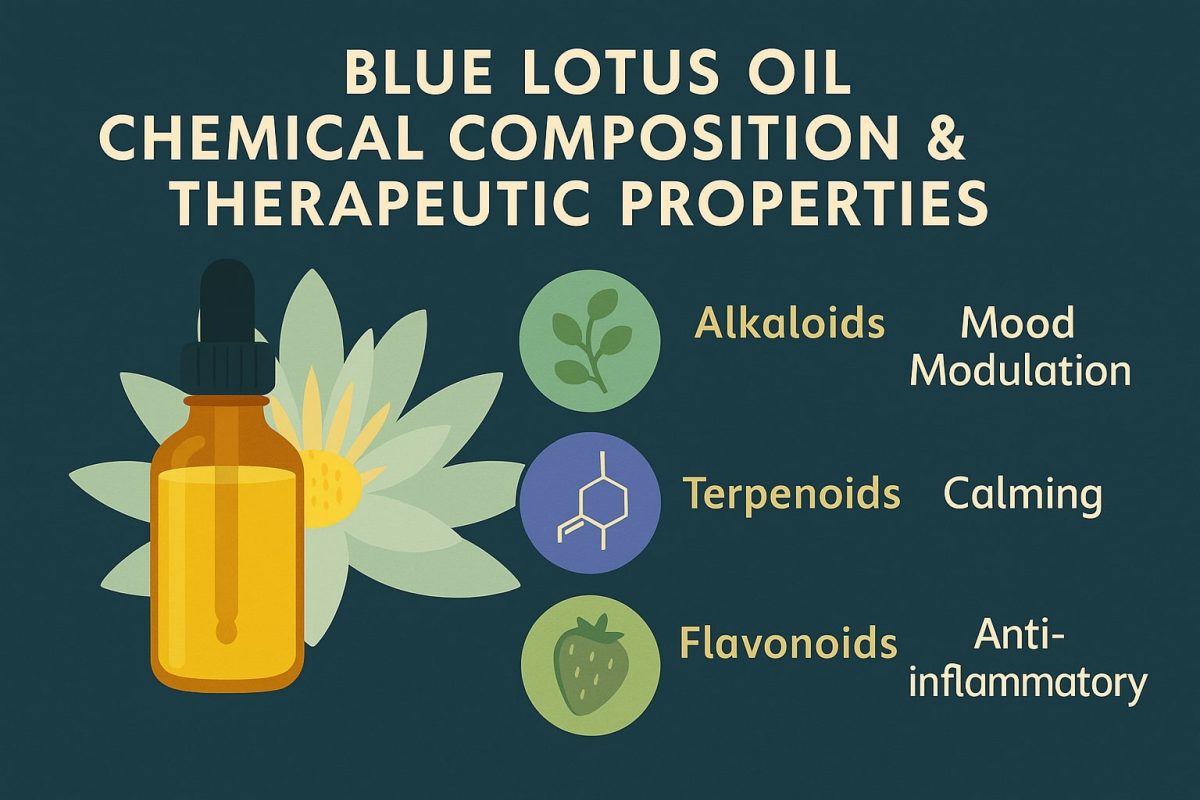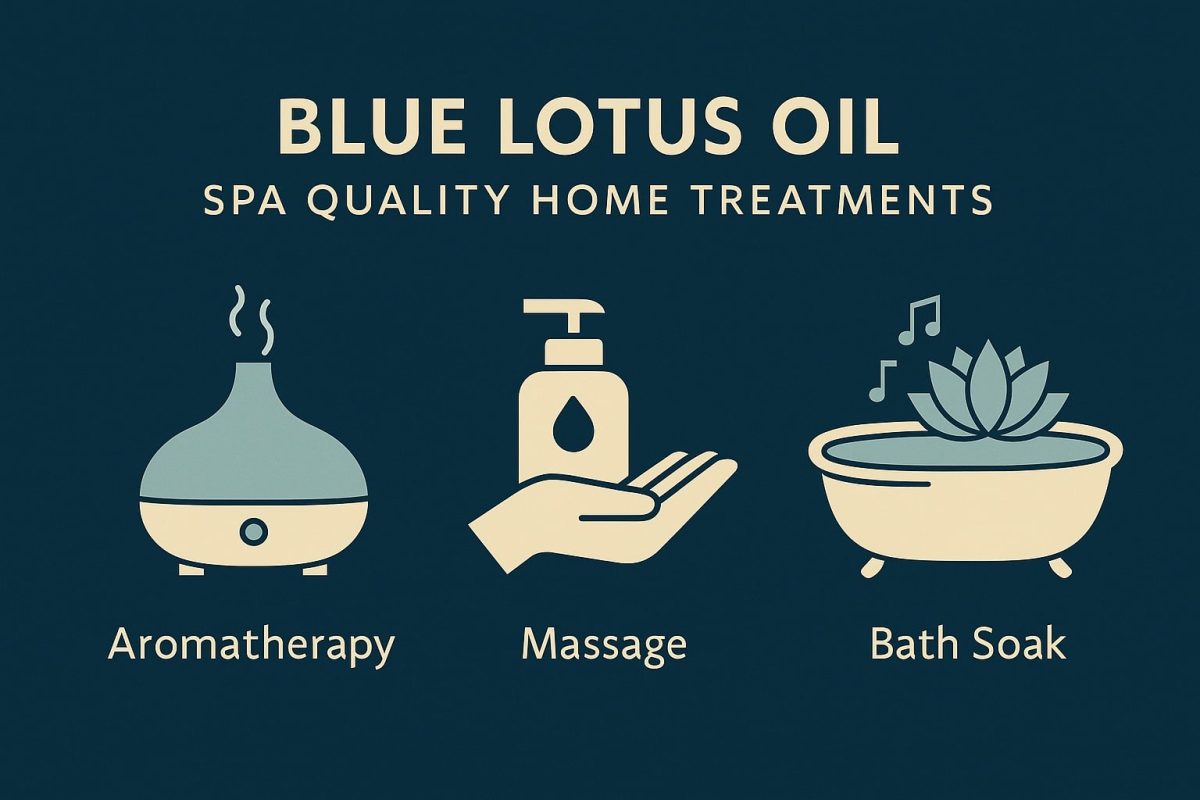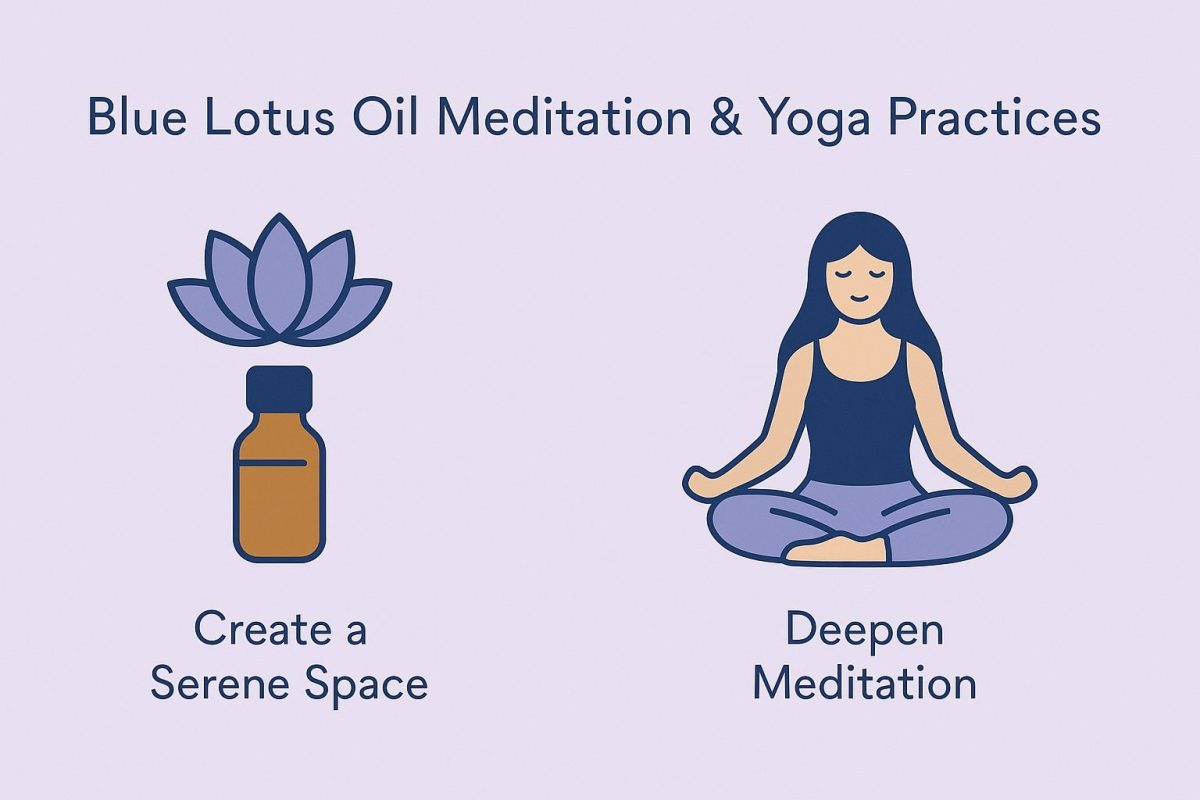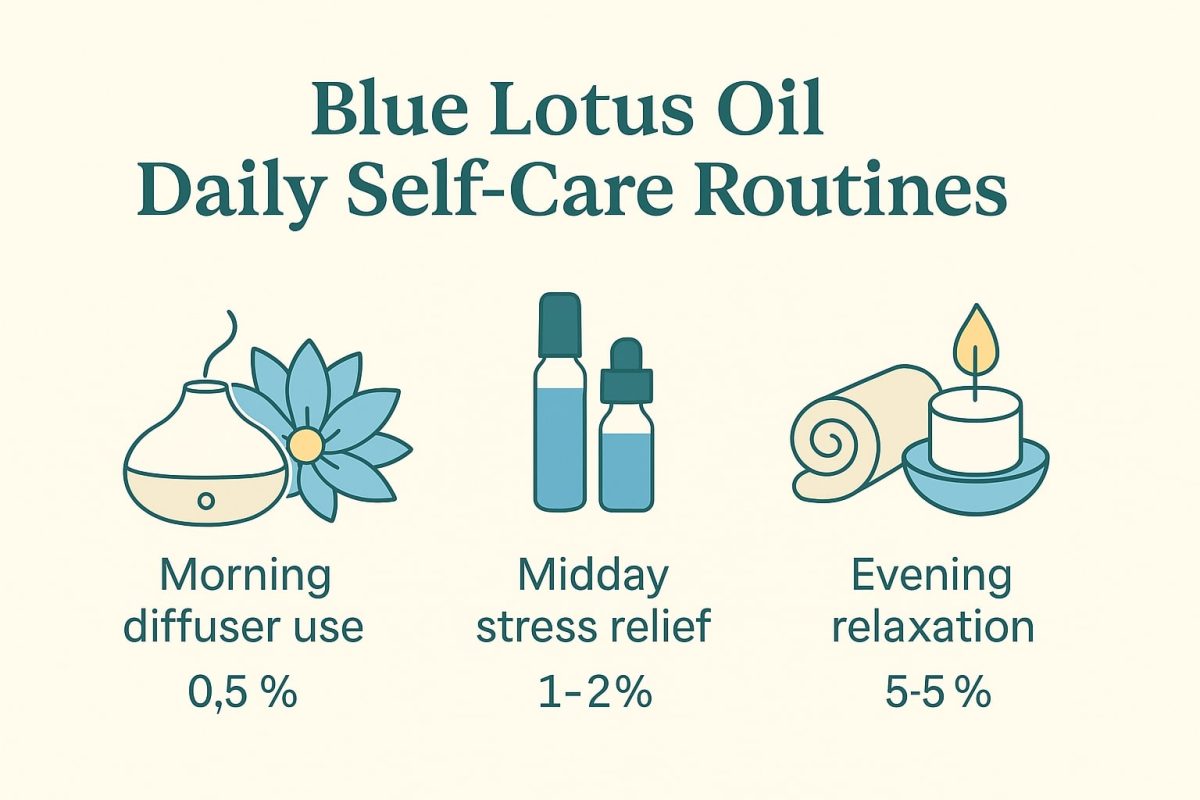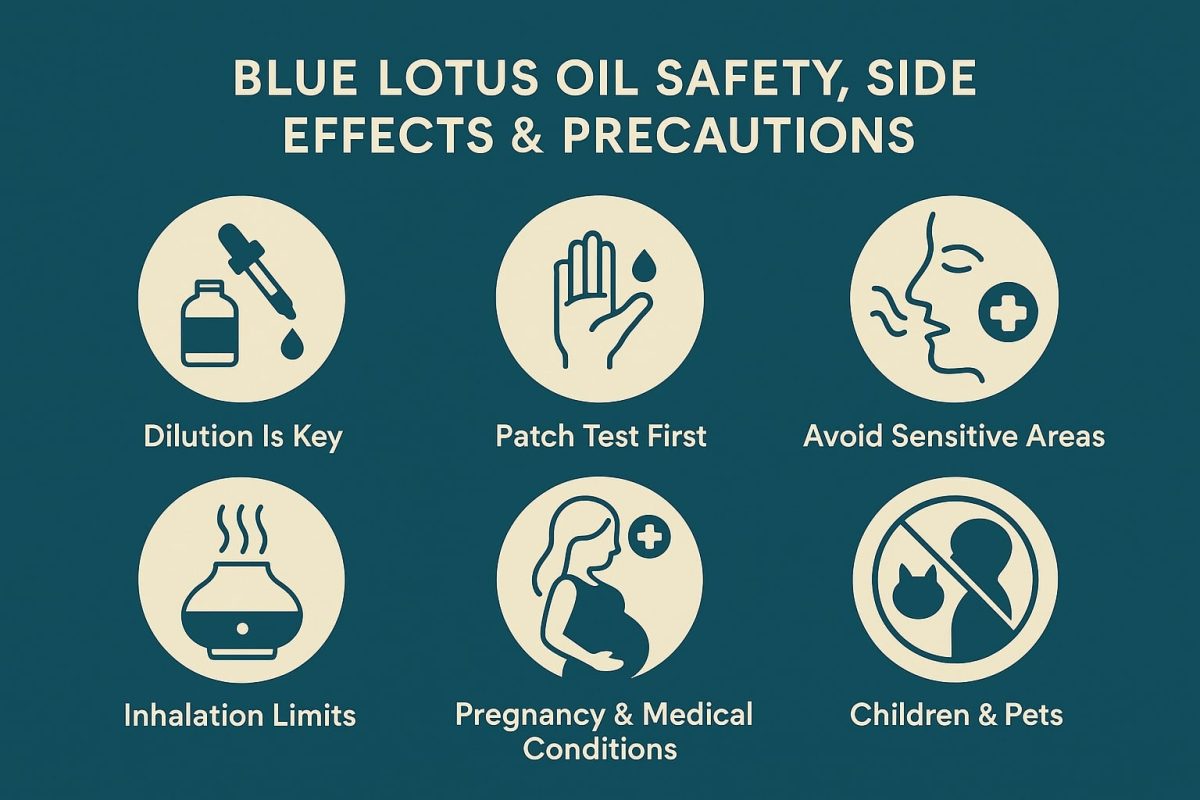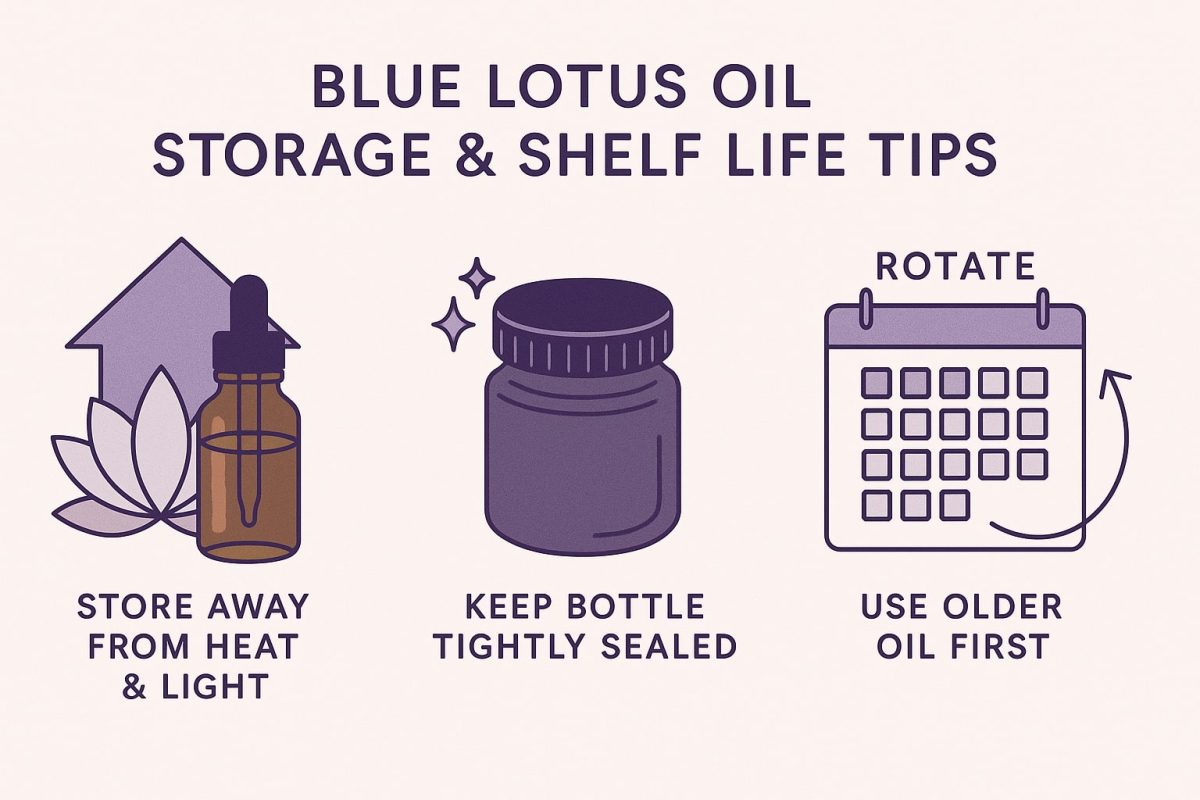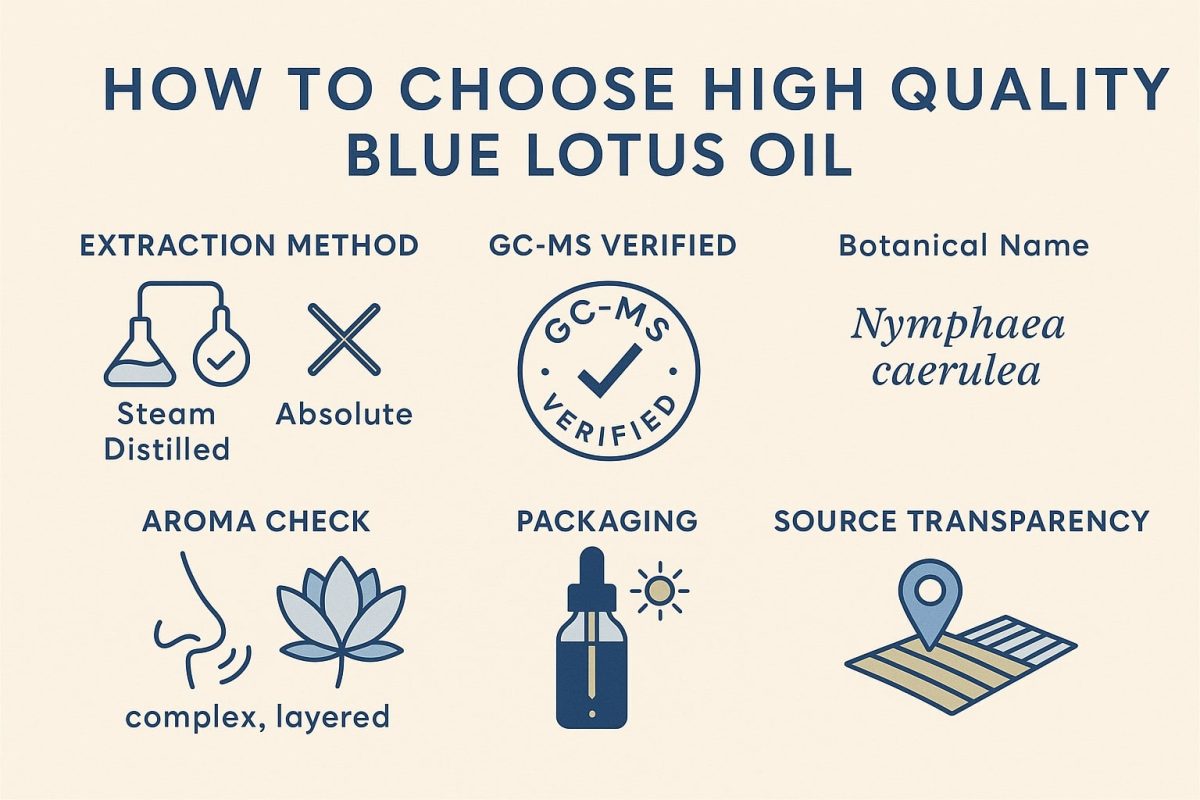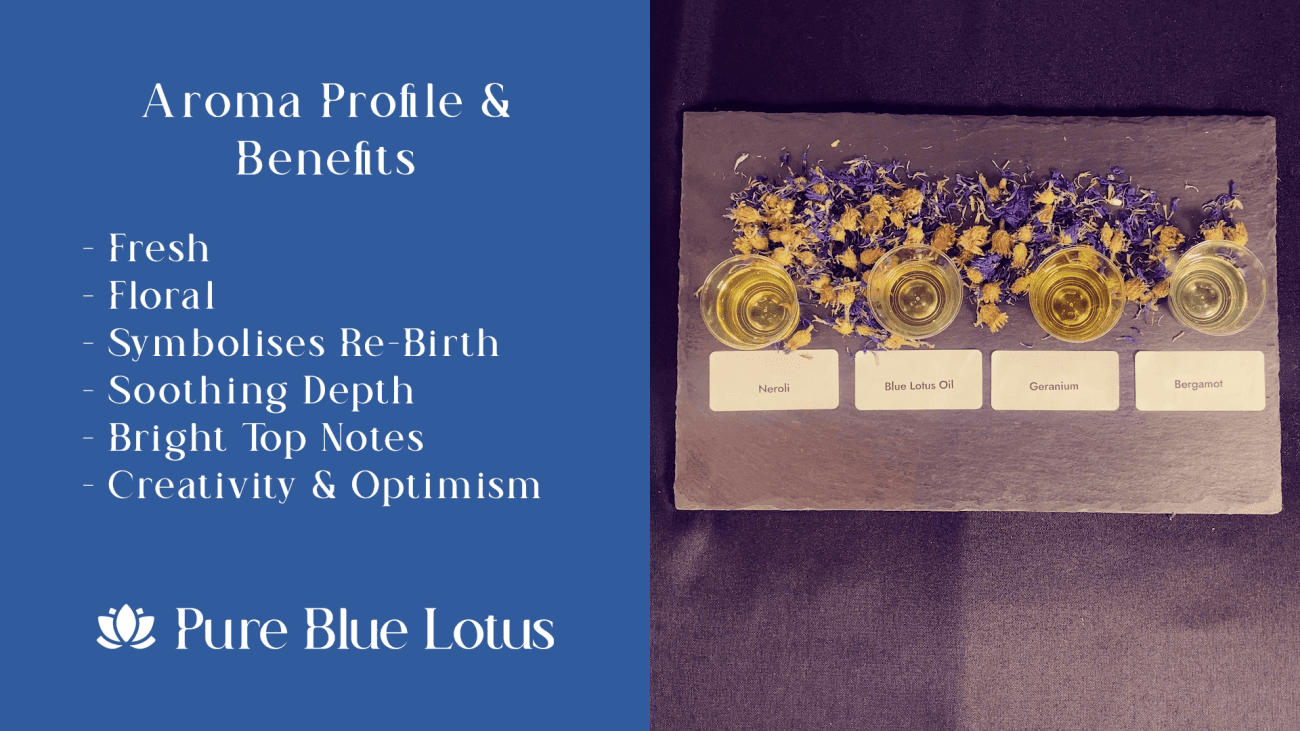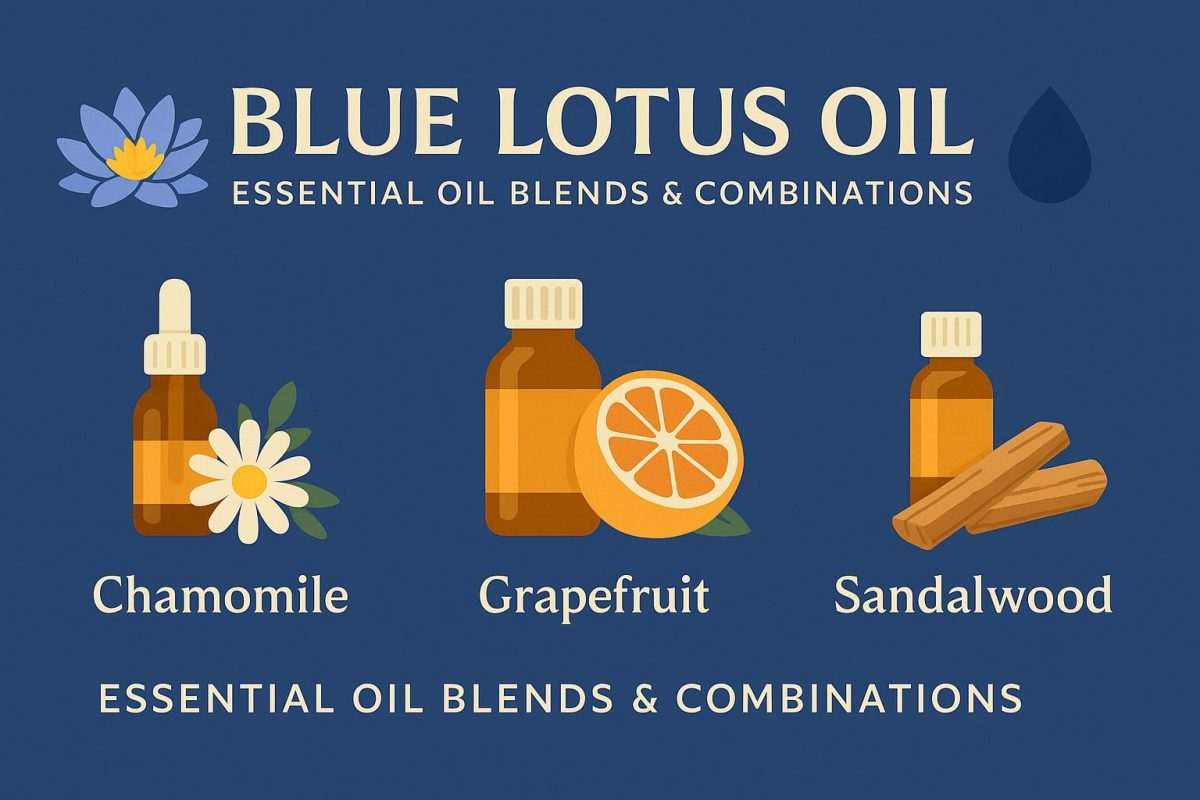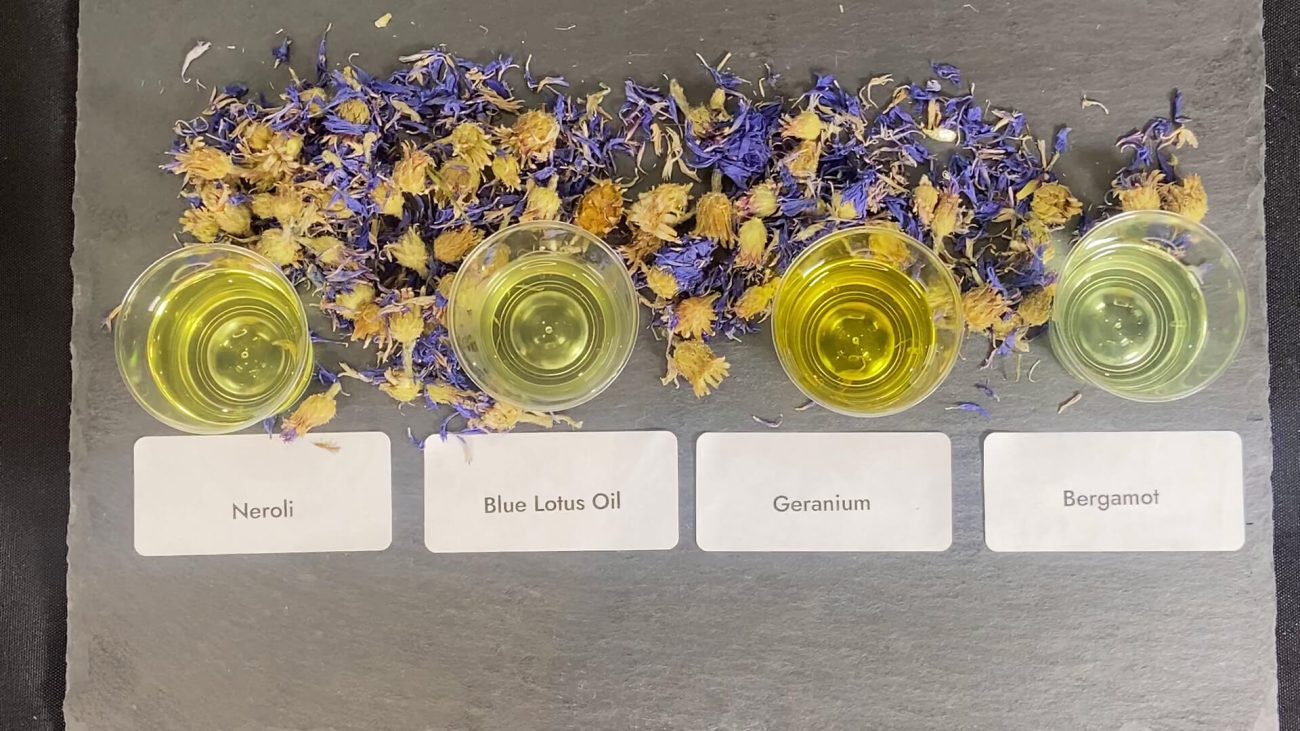Blue Lotus Essential Oil Smell
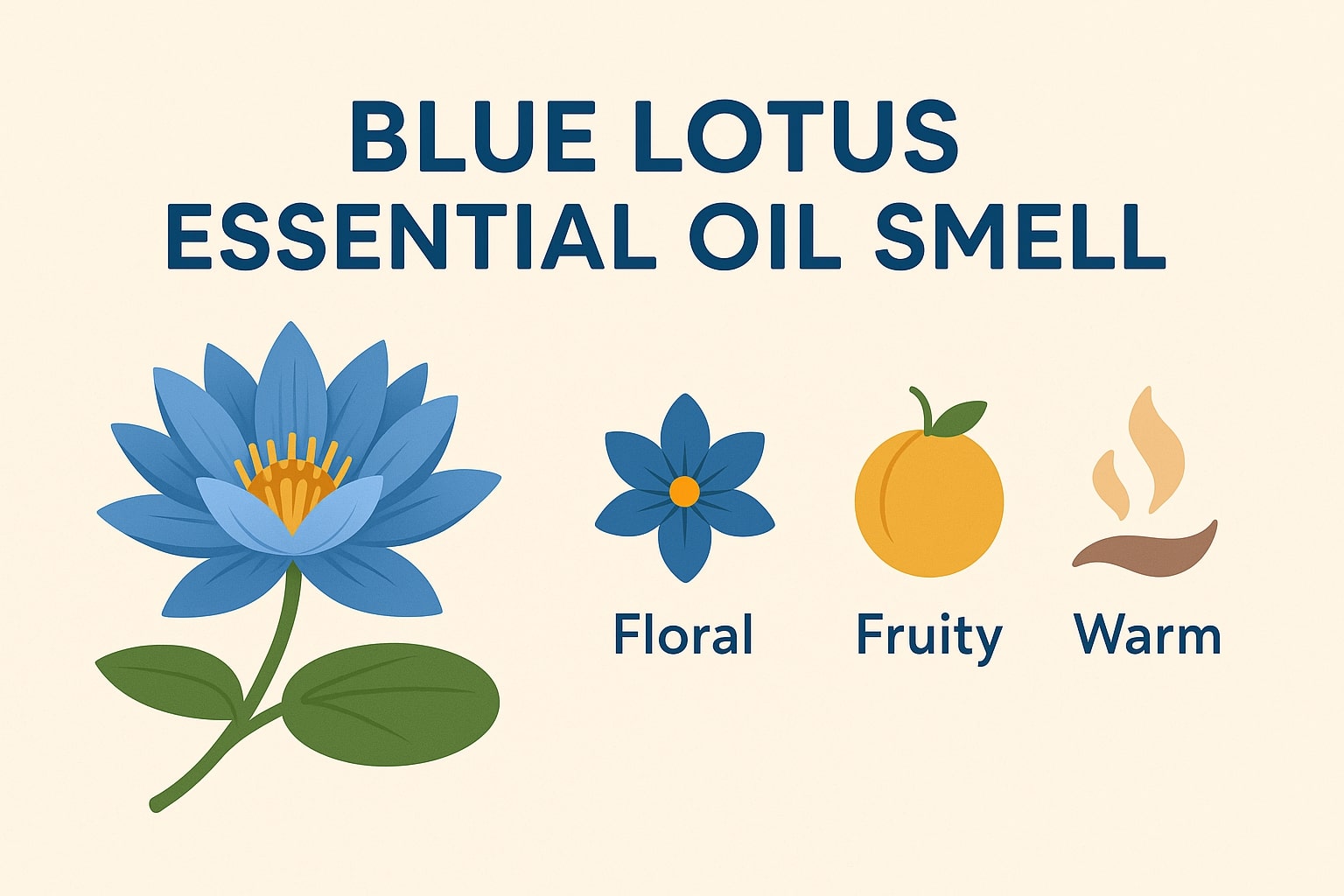
Blue Lotus Essential Oil offers an aroma that can transport you to serene water gardens and ancient temples. Its scent is at once floral, sweet and gently earthy, carrying whispers of honeyed petals floating on still water.
For those seeking the finest, the highest quality Blue Lotus Oil, experience our hand-crafted, pure Luxury Egyptian Blue Lotus Oil (Nymphaea Caerulea) for a truly luxurious addition to your wellness routine. Find out more →
Quick Links to Useful Sections
- Botanical Origins and Cultural History
- Extraction Methods and Fragrance Preservation
- Scent Profile Breakdown
- Chemical Constituents and Olfactory Impact
- Emotional and Psychological Effects
- Practical Applications for the Fragrance
- Creating Custom Fragrance Blends
- Quality and Sourcing Considerations
- Safety Guidelines for Aromatic Use
- User Experiences and Testimonials
- Frequently Asked Questions
This guide will explore everything you need to know about the fragrance of Blue Lotus oil: from its botanical origins and historical significance to the chemical compounds that give it its distinctive profile.
You will learn how to evaluate quality, incorporate it into sensory rituals, blend it with complementary aromas and ensure safe use. By the end, you will understand why Blue Lotus is prized by perfumers, aromatherapists and spiritual practitioners alike.
Commission your made-to-order bottle of pure, undiluted Egyptian Blue Lotus Oil (Nymphaea Caerulea)
Commission your made-to-order bottle of pure, undiluted Egyptian Blue Lotus Oil (Nymphaea Caerulea)
Botanical Origins and Cultural History
The plant known as Blue Lotus, or Nymphaea caerulea, grows naturally in the shallow waters of the Nile River basin and parts of East Africa. Revered by ancient Egyptians, its flowers appear in tomb paintings, temple carvings and hieroglyphs as symbols of rebirth, creation and the daily rising of the sun. Priests and pharaohs infused oils and unguents with lotus aroma to enhance meditation, ritual bathing and spiritual communion. Through trade routes the plant’s fragrant legacy spread to Greece, Rome, India and beyond, becoming an emblem of divine beauty and sensory delight.
In India and Southeast Asia the lotus also took on sacred meaning in Hindu and Buddhist traditions. Devotees offered lotus blossoms at temple altars and used lotus‐infused substances to deepen yoga and meditation practices. Over centuries the botanical lore was passed from apothecaries and herbalists to modern aromatherapy, ensuring that the flower’s mystique lives on in every drop of Blue Lotus Essential Oil.
Extraction Methods and Fragrance Preservation
True Blue Lotus Essential Oil is usually obtained by steam distillation of freshly harvested petals. In this process, steam passes through the plant material, gently releasing volatile aromatic compounds without damaging delicate molecules. The vapor is then condensed and separated into oil and floral hydrosol. Steam‐distilled oil retains the lightest floral top notes, capturing the essence of fresh blooms at sunrise.
For a richer, more complex scent, many producers use supercritical carbon dioxide extraction. At specific pressures and temperatures, carbon dioxide becomes a solvent that pulls out both volatile and semi‐volatile compounds, including heavier wax esters and aromatic resins. When the pressure is released, CO₂ evaporates, leaving behind a pure absolute oil that holds deeper, more tenacious facets of the flower’s aroma.
Scent Profile Breakdown
When you first encounter Blue Lotus Essential Oil, the initial impression is often of a sweet, honey‑like floral note. This sweetness is balanced by a soft, airy florality reminiscent of fresh water lilies and jasmine. Beneath these top notes lies an earthy, almost herbal undercurrent that provides grounding warmth. Some varieties may reveal subtle spice or tea‑like nuances at the heart of the fragrance, while the base retains a gentle muskiness that lingers on the skin and in the air.
In perfumery terms, Blue Lotus oil bridges the floral and green categories, with aquatic and oriental whispers. Its sweetness is never cloying, and its depth invites contemplation, qualities that make it uniquely suited for high‑end fine fragrances and meditative blends.
Chemical Constituents and Olfactory Impact
The aroma of Blue Lotus Essential Oil derives from a complex interplay of phytochemicals. Monoterpenes such as linalool and limonene contribute fresh, floral top notes and mild anxiolytic effects. Sesquiterpenes like nerolidol and farnesol add depth, helping anchor the fragrance and lending anti‑inflammatory properties. Flavonoids such as quercetin and kaempferol are not highly aromatic but support skin health and antioxidant activity. Alkaloids including nuciferine may influence mood and cognitive focus when the scent is inhaled.
This combination of volatile and semi‑volatile compounds gives Blue Lotus its characteristic sweet‑floral opening, nuanced heart and softly earthy finish. Understanding these chemical profiles helps aromatherapists create blends that maximize the oil’s emotional and therapeutic potential.
Emotional and Psychological Effects
Sensory science shows that floral aromas can reduce cortisol levels, promoting a state of calm alertness. Blue Lotus Essential Oil’s unique scent profile appears particularly effective at easing anxiety and fostering mental balance. Many users report enhanced creativity and intuitive insight when diffusing the oil in workspaces or meditation rooms. The subtle sweetness can also uplift mood, making it a valuable companion during challenging times.
In guided imagery and relaxation exercises, the scent of Blue Lotus helps anchor the mind and facilitate deeper states of mindfulness. As you breathe in its gentle aroma, your body receives cues to relax tense muscles and slow racing thoughts, allowing you to remain present and centered.
Practical Applications for the Fragrance
Blue Lotus Essential Oil can be used in a variety of ways to integrate its aroma into daily life. Diffusion is the most popular method: add three to five drops to an ultrasonic diffuser for up to thirty minutes in a well‑ventilated room. This creates a serene environment for yoga, meditation or unwinding after work.
For personal fragrance, dilute the oil at two to four percent in a neutral carrier such as fractionated coconut or jojoba oil. Apply to pulse points, inner wrists, behind ears and base of throat, to enjoy the scent’s evolution throughout the day. The oil’s heart notes emerge more strongly on skin warmed by body heat.
A bath oil blend is another luxurious option. Combine ten drops of Blue Lotus oil with a quarter cup of unscented bath salts or a tablespoon of carrier oil. Add to warm bathwater and soak for twenty minutes, inhaling the steam and massaging the skin to release aromatic compounds and nourish the body.
Creating Custom Fragrance Blends
Blue Lotus Essential Oil blends beautifully with other oils that share its floral or oriental character. Try pairing it with rose otto or lavender for a gentle, elegant bouquet. For greater depth, combine it with sandalwood or patchouli to anchor the florals in a warm, woody base. A touch of citrus, such as bergamot or sweet orange, can brighten the blend and lift the overall mood.
Sample blend for meditation: five drops Blue Lotus, three drops frankincense, two drops sandalwood in ten milliliters carrier oil. This combination marries the uplifting floral notes with resinous grounding, supporting both expansion and rooted awareness.
Quality and Sourcing Considerations
Because authentic Blue Lotus Essential Oil is rare and prized, purity can vary. Always verify that the supplier provides third‑party GC‑MS reports confirming the botanical name Nymphaea caerulea and absence of synthetic additives. Steam‑distilled oils offer true volatile profiles, while CO₂ absolutes capture heavier, nonvolatile constituents. Choose organic, wildcrafted or ethically cultivated sources to support sustainable practices and avoid contamination.
Safety Guidelines for Aromatic Use
Though Blue Lotus oil is generally gentle, it should be used responsibly. Perform a patch test by diluting one drop in five milliliters of carrier and applying to the inner forearm. Wait 24 hours for any reaction. Keep dilution between one and three percent for topical applications, and limit diffuser sessions to 30 minutes at a time in a ventilated room. Consult a healthcare professional before using the oil if you are pregnant, nursing or have respiratory conditions.
User Experiences and Testimonials
“Diffusing Blue Lotus before my evening meditation has become my new ritual. I feel calmer and can hold my focus more easily.” – Elena, yoga instructor
“I wear my Blue Lotus blend as a personal scent. It’s light and floral but never overpowering. Colleagues often ask what perfume I’m wearing.” – Marcus, graphic designer
“After a particularly stressful week, I added a few drops to my bath. The soft, sweet aroma helped me unwind and sleep more soundly.” – Priya, accountant
Frequently Asked Questions
What does Blue Lotus Essential Oil smell like?
It opens with a honey‑sweet floral note, transitions to a delicate water lily heart, and finishes with a gentle earthy or musky base. Some batches reveal subtle herbal or tea‑like nuances.
How long does the scent last?
When diffused, the aroma can linger for up to an hour in a closed room. On skin, a well‑diluted blend may last four to six hours, gently evolving through its notes.
Can children use Blue Lotus oil?
Use caution. For children over two years old dilute to 0.5 percent and perform a patch test. Always consult a pediatrician for topical or aromatic use with young children.
What is the difference between essential oil and absolute?
Essential oils are obtained by steam distillation and capture volatile compounds. Absolutes require solvent or CO₂ extraction to obtain heavier aromatic molecules, resulting in a richer, more tenacious scent.
How should I store my Blue Lotus Essential Oil?
Keep in a dark glass bottle, stored in a cool, dry place away from direct sunlight. Proper storage preserves aroma and extends shelf life to 18–24 months.
For those seeking the finest, the highest quality Blue Lotus Oil, experience our hand-crafted, pure Luxury Egyptian Blue Lotus Oil (Nymphaea Caerulea) for a truly luxurious addition to your wellness routine. Find out more →

